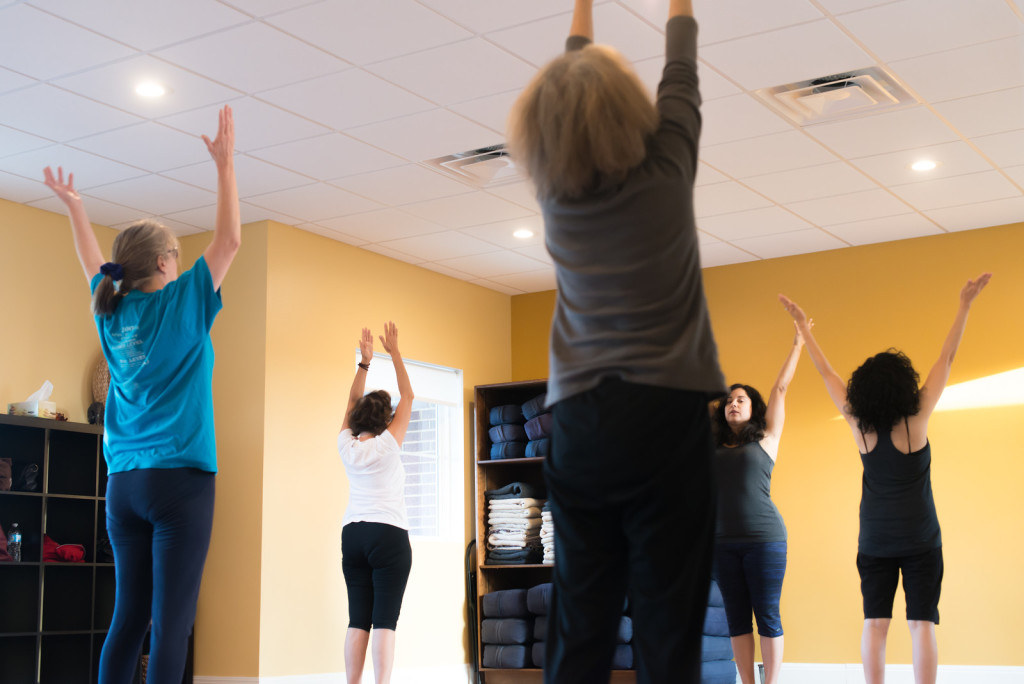6 Yoga Teacher Tips for Remembering Peoples' Names
Our yoga students consistently comment that they can't believe how we remember everybody's names. The truth is, the more classes a teacher teaches per week, the more challenging it can become. Here are six tips that will have you greeting yoga students (and everybody you meet!) by name in no time at all!
 1. Repeat their name back to them when they first say it.
1. Repeat their name back to them when they first say it.
"Nice to meet you Susan. I am so glad you are here for class today." Saying it back right away will increase your odds of remembering it.
2. Make eye contact when they tell you their name, and remember a detail about their face.
This detail might help you with memory recall. Something like, "Max has green eyes." Then, the next time you see Max, you might not remember his name at first, but the detail about him can help you pull it up in your mind.
3. Connect their name with a physical issue and/or their goal.
This is my personal favorite because it helps not only with remembering their name but with following up on their progress with their practice, i.e. "Kate has knee problems."
Then, when Kate comes back to class, I can recall her name and show that I am interested in her and her practice. "Hi Kate, how is your knee doing? What improvements are you noticing with your yoga practice?"
4. Stand at the front desk during class sign-in, or by the door to the classroom, and personally greet each student.
Seeing them come in helps you in a few ways. You can note what their energy is like as they come into the studio, you can see movement patterns in their body, and you can catch their name if they are new or you don't remember it off hand.
5. Check in with each new person before the start of class.
This is something that has worked for me over the years. I stop by their mat and see how they are doing, if they have any injuries, and re-introduce myself if I don't remember their name. This gives me a chance to personally connect with each person in the room.
6. Repetition, repetition, repetition.
Have the students introduce themselves and tell you how they're doing at the start of every class. The more you hear it, the better you will remember. This practice helps you get updates on how each student is feeling and it also helps students to get to know one another as well.
These tips work great for remembering yoga students' names, but with a couple of little tweaks they can be great for remembering the name of anyone you meet! Try them out and let us know which ones work best for you, or share a tip of your own!
 Best regards,
Emily
Best regards,
Emily
Emily Loupe is a yoga teacher, yoga therapist, the creator and director of The Yoga Room's 200 Hour Teacher Training Program, and a self-professed yoga nerd who has completed more than 2500 hours of Teacher Training in a variety of disciplines and specializations.
Yoga Teachers: 10 Tips for New Yoga Teachers
As a new yoga teacher, there are so many things you are hoping to accomplish in the span of one class. You want to make sure your the practice is appropriate, safe, and beneficial for your students. You want to help them find a sense of calm and peacefulness. You want them to enjoy the class so they'll keep coming back.
Trying to meet all these objectives can make teaching become overwhelming! Follow these tips to help you stress less about teaching so you can fill your classes and grow your student base.
1. Find Your Unique Voice When you first start out teaching, it can be difficult to have your own, unique voice. Remember what it is you want to communicate to students and be true to what made you want to teach yoga.

2. Avoid Overusing "I" Statements. Students want to know you can relate to them and vice versa, but it is not about you. Students are in class to have their own experience, to heal their own pain, to explore their own inner spaces. Telling too many personal stories can pull students out of achieving these things.
3. Say Things That Are Meaningful Not every moment needs to be filled with dialog. Choose your words mindfully and try to avoid talking for the sake of talking. Allow students some breathing room to just be without the need to listen and take in more information.
4. Try to Avoid Using Filler Language "Um", "ok", "so", and whatever other words you may not even be aware you're in the habit of saying.
5. Speak Clearly And Concisely As you start out teaching, it might be tempting to use some of the more complicated anatomical terms you learned in teacher training, but what students want is simple and easily understood language. This is especially true if you are teaching beginners.
6. Try to Avoid Using A Great Deal Of Jargon Or Yoga Lingo Using Sanskrit can be a great way for students to start to learn some of the words and terms commonly used in yoga, but using it gratuitously can overwhelm and frustrate newer students. Find a balance such as using the English word or phrase immediately before or after the Sanskrit so students can comprehend what you are communicating.
7. Record Or Film Yourself Teaching If you're not sure what you sound like teaching, take the time to record yourself or even better - film yourself - teaching so you can better understand how you come across and what tweaks you can make to create the best student experience possible.
8. Create Consistency In Your Teaching Knowing what you want to convey to your students, and what your message is as a teacher, is key to creating consistency in your teaching. Being consistent allows students to understand what to expect when they attend your classes.
9. Get To Know Your Students And Their Stories Make yourself available for a few minutes before and after class to talk with your students about their motivations for coming to class. Being present to your students' needs lets them know you are invested in their progress and wellbeing.
10. Start And End Classes On Time Being punctual in beginning and ending classes shows respect for your students' time for the studio or location where you teach. Students want to know they can rely on getting out of class when they expect to, and they also want to experience a full class. Doing this shows professionalism and will be appreciated by those in your class as well as those who run the studio or space where you teach.
We'd love to hear your "best practice" tips for yoga teachers! Please share your thoughts in the comments below, and share our post with your yoga friends to help us extend our reach! :)
